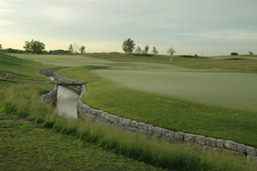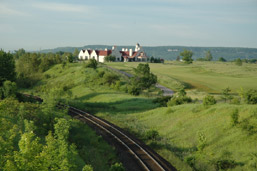Course review: Glencairn Golf Club (Thomas McBroom)
Along with Eagles Nest in north Toronto, Glencairn was hotly tipped as a strong faux links when it opened last year. There's lots to like at Glencairn, but there's also some shortcomings which hold the course back from being considered the best work Toronto architect Thomas McBroom has done.

Built in a style consistent with the UK's heathlands or links courses, with lots of options for a ground game and several ways to attack pins, Glencairn shows McBroom can get it right not far from a spot where many think he got it wrong. That's because Glencairn is built just up the street from Rattlesnake, an earlier design on a similar piece of property. One Clublink insider told me that Rattlesnake was the organization's big miss -- a sprawling, 36-hole project where little really stands out.
Unlike Rattlesnake, McBroom has aimed at a distinctive look for Glencairn, somewhere between Scotland's Muirfield and the King's course at Gleneagles.
Though it starts out a bit oddly, with a short par four, the "Leithfield" nine is the course's standout. The look is similar to Muirfield and it is built over similar, gently rolling land. The par five second hole is a standout, with its strategic bunkering and interesting greensite. The 470-yard par four sixth is also a strong hole, reminiscent of the eighth or ninth at Muirfield -- strong holes that force the good player to hit two honest shots in order to make par.
While Leithfield is the standout, that doesn't mean there isn't lots to like in the other 18 holes, located to the north and east of the property. The Speyside's first hole, a 450-yard par four is without doubt the most dramatic, exciting and fascinating hole on the entire course. It is unclear how much land McBroom moved to create the hole (I'd wager a fair bit), but the hole is among the best the designer has ever created. Essentially a straight hole, bunkers sit on either side of the fairway in the landing zone. From there, the hole plunges downward towards a green situated in the hillside of a slight rise. The green, which features an angled ridge that forces players to be careful with any pitch, is interesting. A worthy sidenote on the greens at Glencairn -- unlike most of McBroom's early work, which featured wild undulations, the putting services at Glencairn are relatively tame. Its too bad -- a little more life in these would have added to the links concept.
But not everything is good on the Speyside and Scotchblock nines. Both head to the east and across a series of railway tracks. Along the way, they run into environmental hazards which disrupt the links theme and the flow of the course. There are some big misses here -- like the Scotchblock's 8th, with its hazards placed all along the right side, meaning a poor tee shot will be doubly punished, and the Speyside #6, a par five with a significant hazard situated in the middle of what one would expect to be the landing area for one's tee ball.
So where does this leave Glencairn? It is a good, but flawed golf course. The setting and general themes are nice -- the clubhouse is a standout, the burns are nicely done and two-thirds of the course is conceptually well done.

One can only wonder what it could have been should Clublink have considered doing 18 holes, rather than forcing 27 into an area where fewer would have sufficed.

Built in a style consistent with the UK's heathlands or links courses, with lots of options for a ground game and several ways to attack pins, Glencairn shows McBroom can get it right not far from a spot where many think he got it wrong. That's because Glencairn is built just up the street from Rattlesnake, an earlier design on a similar piece of property. One Clublink insider told me that Rattlesnake was the organization's big miss -- a sprawling, 36-hole project where little really stands out.
Unlike Rattlesnake, McBroom has aimed at a distinctive look for Glencairn, somewhere between Scotland's Muirfield and the King's course at Gleneagles.
Though it starts out a bit oddly, with a short par four, the "Leithfield" nine is the course's standout. The look is similar to Muirfield and it is built over similar, gently rolling land. The par five second hole is a standout, with its strategic bunkering and interesting greensite. The 470-yard par four sixth is also a strong hole, reminiscent of the eighth or ninth at Muirfield -- strong holes that force the good player to hit two honest shots in order to make par.
While Leithfield is the standout, that doesn't mean there isn't lots to like in the other 18 holes, located to the north and east of the property. The Speyside's first hole, a 450-yard par four is without doubt the most dramatic, exciting and fascinating hole on the entire course. It is unclear how much land McBroom moved to create the hole (I'd wager a fair bit), but the hole is among the best the designer has ever created. Essentially a straight hole, bunkers sit on either side of the fairway in the landing zone. From there, the hole plunges downward towards a green situated in the hillside of a slight rise. The green, which features an angled ridge that forces players to be careful with any pitch, is interesting. A worthy sidenote on the greens at Glencairn -- unlike most of McBroom's early work, which featured wild undulations, the putting services at Glencairn are relatively tame. Its too bad -- a little more life in these would have added to the links concept.
But not everything is good on the Speyside and Scotchblock nines. Both head to the east and across a series of railway tracks. Along the way, they run into environmental hazards which disrupt the links theme and the flow of the course. There are some big misses here -- like the Scotchblock's 8th, with its hazards placed all along the right side, meaning a poor tee shot will be doubly punished, and the Speyside #6, a par five with a significant hazard situated in the middle of what one would expect to be the landing area for one's tee ball.
So where does this leave Glencairn? It is a good, but flawed golf course. The setting and general themes are nice -- the clubhouse is a standout, the burns are nicely done and two-thirds of the course is conceptually well done.

One can only wonder what it could have been should Clublink have considered doing 18 holes, rather than forcing 27 into an area where fewer would have sufficed.


 Blog Directory
Blog Directory

1 Comments:
better hit it straight, or the fescue will kill.
The sod wall bunkers can punish unlike any "normal" bunkers.
Overall, a good round at Glencairn would be a great round anyhereelse!
Post a Comment
<< Home